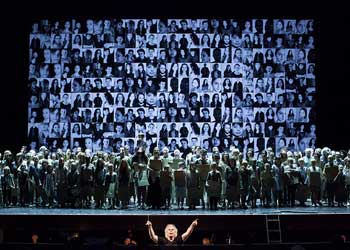The Monster in the Labyrinth

This “marvellous” and “enchanting” performance, according to the critics at its premiere, recreates the voyage of Theseus to Crete to rescue the Athenian children expelled and offered up as sacrifices to the terrible Minotaur. Interwoven with strong symbolism, the opera featuring performances by children, young persons and adults, brings together a large number of amateur singers who are joined by the Gulbenkian Choir and Orchestra.
With music by the British composer Jonathan Dove, the libretto by Alasdair Middleton, staged by Marie-Eve Signeyrole and with the scenography by Fabien Teigné, this performance counts on the musical direction of Quentin Hindley and the participation of singers Carlos Cardoso (Theseus), Cátia Moreso (mother of Theseus) and Rui Baeta (Daedalus) and as well as the actor Fernando Luís (Minos).
In July, during the rehearsal period, the scenographer Fabien Teigné and his two stage assistants, Marc Salmon and Maud Billen, explained how this unique project represents a continually renewing challenge to the creative team as well as for the production and stage team in general. Referring to the origins of the opera, Teigné explained that the idea came out of the Aix-en-Provence Festival, leveraged by an important partnership that involves the Berlin Philharmonic Orchestra and the London Symphony Orchestra. Following its premiere in Aix, the project was then presented in London and in Berlin with each performance taking on a distinctive fashion even while always under the British maestro Simon Rattle, who also conducted the premiere.
The scenographer places emphasis on the pedagogical and social facets to this project that has involved a large number of amateur choir singers who join up with a professional choir and orchestra along with the four soloists. Teigné does not consider it particularly difficult to work with such a diversified group (around one hundred adults, one hundred adolescents and about fifty children) because, as a general rule, the rehearsals take place over a significant period of time, whether in the school holidays or at weekends and are preceded by explanation sessions about the project so that “everybody may integrate and they may artistically defend it”. Afterwards, there comes a process of technical work with all of the voices and movements on stage. Thus, everything gets processed “stage by stage” in this project that “does not hold the objective of discovering vocations but provides an enriching experience for all participants”, enabling “persons from various generations and various social classes to bring the opera hall into their city”.
Marc Salmon, who has also accompanied all of the productions of this opera thus far held, says that each production always necessarily starts out from zero which, he confesses, “is simultaneously fascinating and terrible”. And he gave an example: in Lisbon, the rehearsals began in November 2016, but with longs intervals in between. Meanwhile, in Montpellier, where this performance was also presented, the rehearsals lasted around three months. “In April of this year, after an intense period of work in Montpellier, we got satisfaction from finally seeing the performance take to the stage and with great success. However, as soon as the following weekend, when we returned to Lisbon to resume rehearsals, we still had it almost all to do all over again” (laughter). He then confesses that the sensation was somewhat discouraging but while still knowing that there is a long path to travel for every production.
Maud Billenin turn, highlights how the project enables many amateurs to gain a truly professional experience and that, for many, this shall be their only such opportunity in their lives. Many have to dash from their jobs (or schools) to get to rehearsals on time and correspondingly complying in a very professional and dedicated fashion with all of the scheduled phases.
This is, indeed, a key idea of this project that is backed up by Fabien Teigné: “The artistic and technical team is the same that produces performances with totally professional performers and hence the amateurs are not treated as such. They have to show the same energy, the same presence on stage and the same professional conscientiousness as the rest of the team so that they may reach as far as possible.” This is not always easy, he admits, because “sometimes, the young have their exams coming up, the children are tired and the adults have their jobs and their family”.
As regards the theme of the work, a Greek myth, Teigné explains how this artistic team normally focuses on making contemporary readings of classical texts, adapting them to a closer reality more able to touch them. “Based upon this theme, we wanted to depart to talk of another that is unfortunately very much in the headlines and that relates to the drama of the refugees arriving daily in Europe.” Salmon stresses the fact that the images of this reality, broadcast on television and so constantly repeated, have ended up causing a generalised indifference. “By placing its finger on reality, art crystallises, becomes capable of creating emotion, ending by touching us deeper than any media report might. Many people leave this performance both moved and disturbed.”
See agenda
